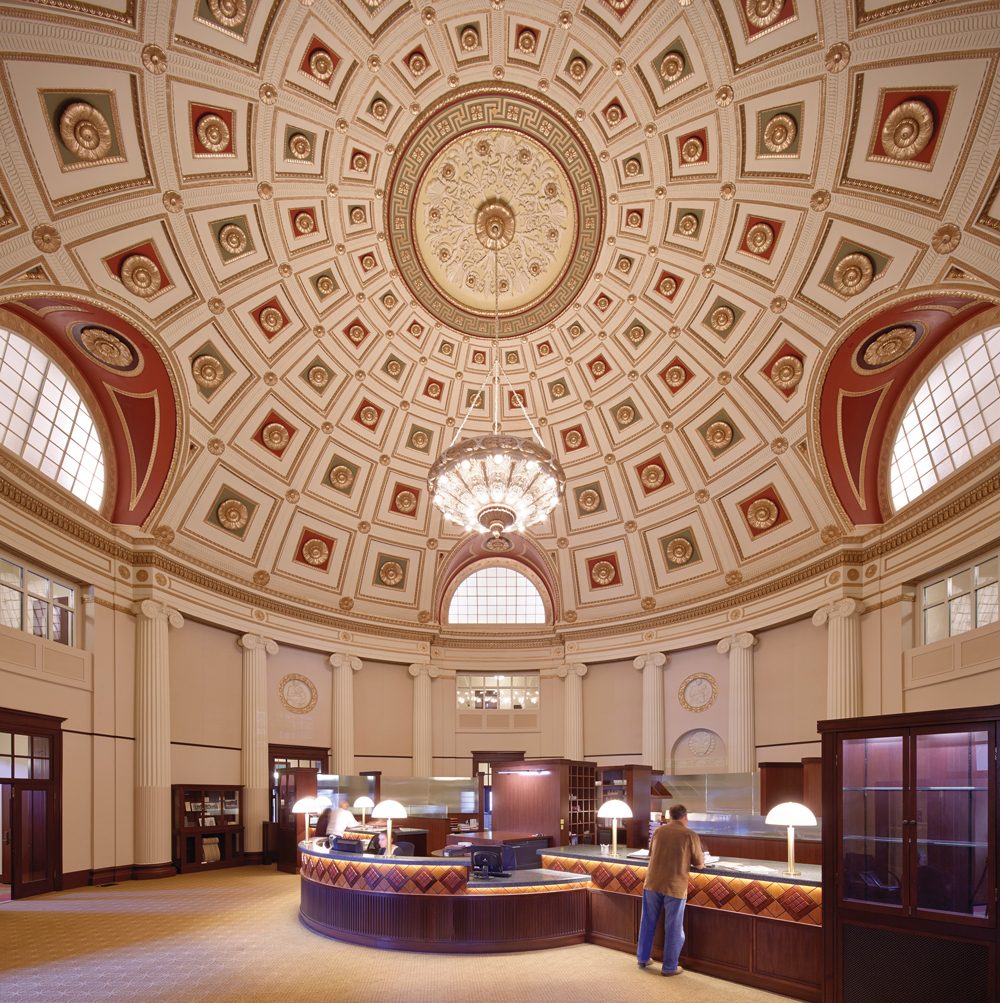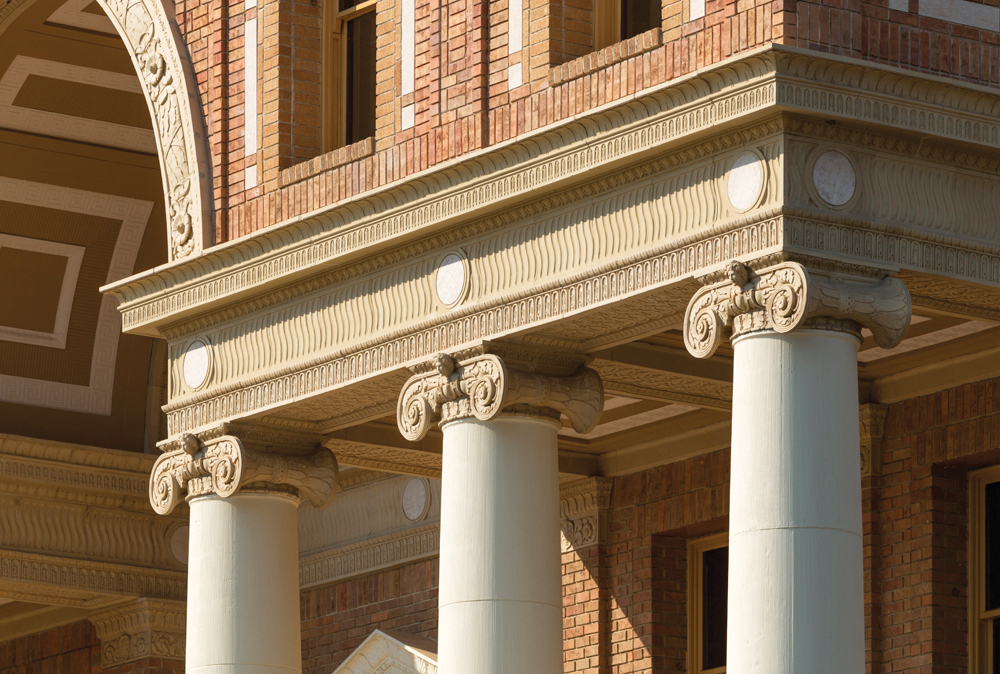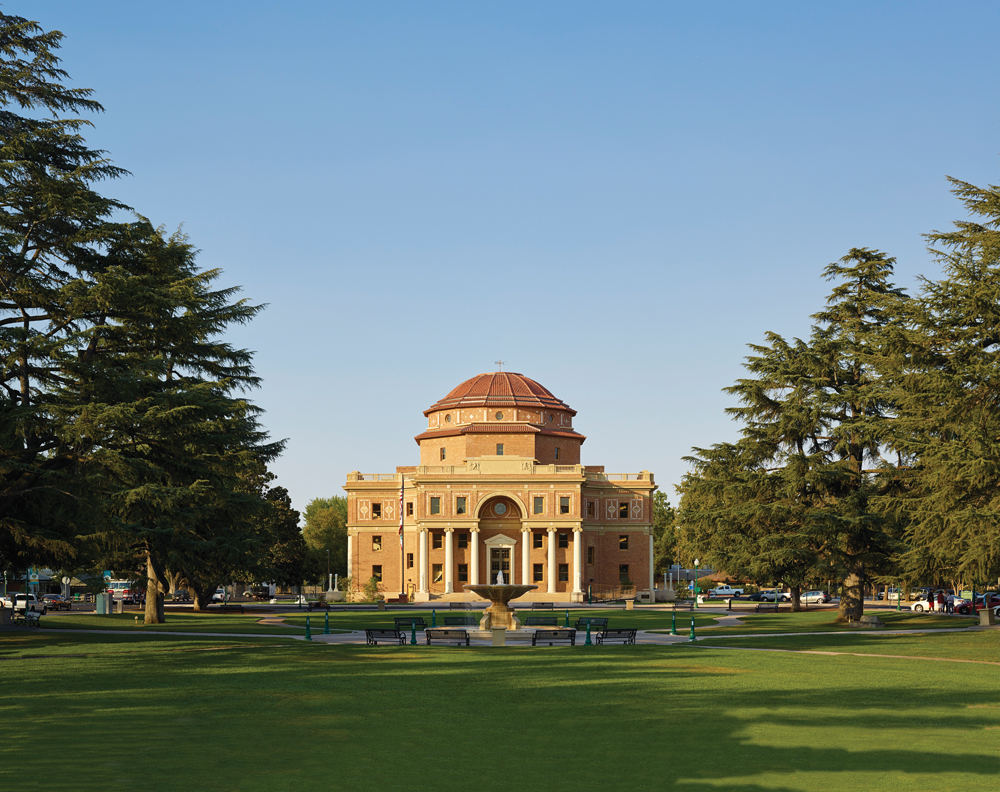Upon its completion in 1918, the building that is now the Atascadero (Calif.) City Hall was the very picture of stability. Intended as the centerpiece of Atascadero Colony—a planned utopian community—the Italian Renaissance structure featured a cruciform plan, with ornate central rotundas on the first and fourth floors.
Though the idealized colony never really jelled, the area did thrive, and the building passed through several commercial uses before the County of San Luis Obispo acquired it in 1950. When the city of Atascadero was incorporated 29 years later, the county handed the building over for city offices. The hall, with its grand pillared entrances and red-tiled dome, is featured on the city seal and listed on both the National and California Registers of Historic Places.
In December 2003, the 6.5 magnitude San Simeon earthquake ravaged Atascadero. As city workers dove for cover, the upper rotunda was twisted and wrenched away from its structural moorings. Interior walls and exterior masonry were extensively damaged, and the building was ultimately red-tagged. However, city officials were determined to restore, and improve, the beloved landmark.
Pfeiffer Partners Architects undertook a two-year assessment, including a laser-scan analysis as well as painstaking physical investigations and measurements. The Atascadero Historical Society, an enthusiastic collaborator, provided invaluable documentation of original conditions. Three packages of work were eventually developed: demolition, FEMA-funded damage repair and hazard mitigation, and city-funded rehabilitation.
PLATINUM AWARD
ATASCADERO CITY HALL
Atascadero, Calif.Building Team
Submitting firm: Bernards (construction manager)
Owner: City of Atascadero
Architect: Pfeiffer Partners Architects
Structural engineer: Nabih Youssef Associates
MEP engineer: Davidovich & Associates
General contractor: Diani Building Corp.General Information
Size: 58,900 sf
Construction cost: $21.7 million
Construction time: June 2010 to September 2013
Delivery method: CM agency/multi-prime
The 2008 economic crash posed financial difficulties, and anticipated state funding was eliminated in the subsequent recession. Meanwhile, water infiltration caused additional damage despite the owner’s best efforts to keep rain out. Under the management of Bernards, construction finally began in 2010, nearly seven years after the quake occurred.
Stabilizing the structure was obviously the most pressing need. The original building consisted of cast-in-place reinforced concrete floors and unreinforced masonry infill walls between a structural steel, concrete-encased post-and-beam skeleton. Above the fourth floor, the building was essentially an unreinforced masonry structure.
Crews strengthened the existing foundation by drilling 248 micro-piles 80 feet deep into bedrock, and pouring pile caps below the foundation. A new structural concrete slab-on-grade was installed at the basement level. Interior perimeter walls up to the fourth floor were stripped to reveal the structure, which was reinforced with more than a million tons of shotcrete and 80,000 pounds of rebar—in essence, creating a building within a building.
To fix the upper floors and dome, crews removed most of the exterior cladding, then rebuilt with additional steel and fiber-reinforced polymer instead of shotcrete, which would have been too heavy. Existing steel was horizontally and vertically braced, and roof dome framing members were retrofitted.
When structural improvements were complete, crews used as much of the original masonry as possible to rebuild the walls and roof. In the heavily damaged upper section, about 15% of the roof tiles and 80% of the bricks had to be replaced with color-matched materials. When possible, original tiles, fascia balustrades, and decorative plaster were repaired, cleaned, and returned to their original spots.

The lower rotunda benefited from a new paint scheme inspired by the greens and browns of the California landscape; the painter, a local artisan, donated half of his change-order hours back to the city. Second-floor window overlooks, once blocked, were uncovered and restored, providing views into the space from surrounding office zones. Light boxes behind frosted lunettes give the illusion of natural daylight. In reality, this dome is internal and is topped by a second rotunda housing the City Council chambers.
IMPROVING INTERIOR DESIGN
Interior reconfiguration was also crucial to improving functionality. Over the years, alterations had resulted in a confusing layout and awkwardly shaped spaces, as well as problematic ventilation. Crews removed most of the interior partitions and built new walls to establish a more sensible floor plan. Efficient HVAC and communications infrastructure was installed.
The lower rotunda was programmed as lobby space and a permit center. Three floors of offices surround this focal point. City Council chambers were constructed in the domed upper rotunda, which once held a library. A small historical museum received a place of honor, reinforcing the building’s link with the town.
More than 90% of construction dollars went to firms on the Central Coast, including $5.5 million to local glass, concrete, and masonry contractors. The final construction cost was $3.3 million less than the original $25 million estimate. Bernards credits the multi-prime contract process, encompassing 17 separately bid categories, for the savings. City Hall opened on schedule in August 2013, just in time for Atascadero’s centennial—an embodiment of civic resilience, determination, and pride.

Elegant detailing, a hallmark of the Italian Renaissance style, was re-established in the post-earthquake reconstruction.
Related Stories
| Aug 11, 2010
Design firms slash IT spending in 2009
Over half of architecture, engineering, and environmental consulting firms (55%) are budgeting less for information technology in 2009 than they did in 2008, according to a new report from ZweigWhite. The 2009 Information Technology Survey reports that firms' 2009 IT budgets are a median of 3.3% of net service revenue, down from 3.6% in 2008. Firms planning to decrease spending are expected to do so by a median of 20%.
| Aug 11, 2010
A glimmer of hope amid grim news as construction employment falls in most states, metro areas
The construction employment picture brightened slightly with 18 states adding construction jobs from April to May according to a new analysis of data released today by the Bureau of Labor Statistics (BLS). However, construction employment overall continued to decline, noted Ken Simonson, the chief economist for the Associated General Contractors of America.
| Aug 11, 2010
Thom Mayne unveils 'floating cube' design for the Perot Museum of Nature and Science in Dallas
Calling it a “living educational tool featuring architecture inspired by nature and science,” Pritzker Prize Laureate Thom Mayne and leaders from the Museum of Nature & Science unveiled the schematic designs and building model for the Perot Museum of Nature & Science at Victory Park. Groundbreaking on the approximately $185 million project will be held later this fall, and the Museum is expected to open by early 2013.
| Aug 11, 2010
SOM's William F. Baker awarded Fritz Leonhardt Prize for achievement in structural engineering
In recognition of his engineering accomplishments, which include many of the tallest skyscrapers of our time, William F. Baker received the coveted Fritz Leonhardt Prize in Stuttgart, Germany. He is the first American to receive the prize.
| Aug 11, 2010
American Concrete Institute forms technical committee on BIM for concrete structures
The American Concrete Institute (ACI) announces the formation of a new technical committee on Building Information Modeling (BIM) of Concrete Structures.
| Aug 11, 2010
10 tips for mitigating influenza in buildings
Adopting simple, common-sense measures and proper maintenance protocols can help mitigate the spread of influenza in buildings. In addition, there are system upgrades that can be performed to further mitigate risks. Trane Commercial Systems offers 10 tips to consider during the cold and flu season.
| Aug 11, 2010
Reed Construction Data files corporate espionage lawsuit against McGraw-Hill Construction Dodge
Reed Construction Data (RCD), a leading construction information provider and a wholly-owned subsidiary of Reed Elsevier (NYSE:RUK, NYSE:ENL), today filed suit in federal court against McGraw-Hill Construction Dodge, a unit of The McGraw-Hill Companies, Inc. (NYSE:MHP). The suit charges that Dodge has unlawfully accessed confidential and trade secret information from RCD since 2002 by using a series of fake companies to pose as RCD customers.
| Aug 11, 2010
Jacobs, HOK top BD+C's ranking of the 75 largest state/local government design firms
A ranking of the Top 75 State/Local Government Design Firms based on Building Design+Construction's 2009 Giants 300 survey. For more Giants 300 rankings, visit http://www.BDCnetwork.com/Giants
| Aug 11, 2010
Brad Pitt’s foundation unveils 14 duplex designs for New Orleans’ Lower 9th Ward
Gehry Partners, William McDonough + Partners, and BNIM are among 14 architecture firms commissioned by Brad Pitt's Make It Right foundation to develop duplex housing concepts specifically for rebuilding the Lower 9th Ward in New Orleans. All 14 concepts were released yesterday.







